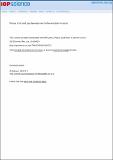| dc.contributor.author | Finer, Matt | |
| dc.contributor.author | Babbitt, Bruce | |
| dc.contributor.author | Novoa, Sidney | |
| dc.contributor.author | Ferrarese, Francesco | |
| dc.contributor.author | Pappalardo, Salvatore Eugenio | |
| dc.contributor.author | Marchi, Massimo De | |
| dc.contributor.author | Saucedo, Maria | |
| dc.contributor.author | Kumar, Anjali | |
| dc.date.accessioned | 2015-03-04T16:14:12Z | |
| dc.date.available | 2015-03-04T16:14:12Z | |
| dc.date.issued | 2015-01 | |
| dc.date.submitted | 2014-10 | |
| dc.identifier.issn | 1748-9326 | |
| dc.identifier.uri | http://hdl.handle.net/1721.1/95794 | |
| dc.description.abstract | The western Amazon is one of the world's last high-biodiversity wilderness areas, characterized by extraordinary species richness and large tracts of roadless humid tropical forest. It is also home to an active hydrocarbon (oil and gas) sector, characterized by operations in extremely remote areas that require new access routes. Here, we present the first integrated analysis of the hydrocarbon sector and its associated road-building in the western Amazon. Specifically, we document the (a) current panorama, including location and development status of all oil and gas discoveries, of the sector, and (b) current and future scenario of access (i.e. access road versus roadless access) to discoveries. We present an updated 2014 western Amazon hydrocarbon map illustrating that oil and gas blocks now cover 733 414 km[superscript 2], an area much larger than the US state of Texas, and have been expanding since the last assessment in 2008. In terms of access, we documented 11 examples of the access road model and six examples of roadless access across the region. Finally, we documented 35 confirmed and/or suspected untapped hydrocarbon discoveries across the western Amazon. In the Discussion, we argue that if these reserves must be developed, use of the offshore inland model—a method that strategically avoids the construction of access roads—is crucial to minimizing ecological impacts in one of the most globally important conservation regions. | en_US |
| dc.description.sponsorship | International Conservation Fund of Canada | en_US |
| dc.language.iso | en_US | |
| dc.publisher | IOP Publishing | en_US |
| dc.relation.isversionof | http://dx.doi.org/10.1088/1748-9326/10/2/024003 | en_US |
| dc.rights | Creative Commons Attribution | en_US |
| dc.rights.uri | http://creativecommons.org/licenses/by/3.0/ | en_US |
| dc.source | IOP Publishing | en_US |
| dc.title | Future of oil and gas development in the western Amazon | en_US |
| dc.type | Article | en_US |
| dc.identifier.citation | Finer, Matt, Bruce Babbitt, Sidney Novoa, Francesco Ferrarese, Salvatore Eugenio Pappalardo, Massimo De Marchi, Maria Saucedo, and Anjali Kumar. “Future of Oil and Gas Development in the Western Amazon.” Environmental Research Letters 10, no. 2 (January 28, 2015): 024003. | en_US |
| dc.contributor.department | MIT-SUTD Collaboration Office | en_US |
| dc.contributor.mitauthor | Kumar, Anjali | en_US |
| dc.relation.journal | Environmental Research Letters | en_US |
| dc.eprint.version | Final published version | en_US |
| dc.type.uri | http://purl.org/eprint/type/JournalArticle | en_US |
| eprint.status | http://purl.org/eprint/status/PeerReviewed | en_US |
| dspace.orderedauthors | Finer, Matt; Babbitt, Bruce; Novoa, Sidney; Ferrarese, Francesco; Pappalardo, Salvatore Eugenio; Marchi, Massimo De; Saucedo, Maria; Kumar, Anjali | en_US |
| mit.license | PUBLISHER_CC | en_US |
| mit.metadata.status | Complete | |
